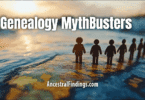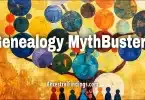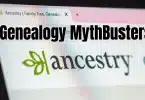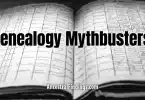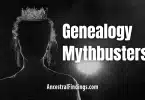The internet has changed genealogy forever. A few clicks can uncover census records, passenger lists, or even digitized newspapers that once took months of travel and library time to access. Companies like Ancestry, FamilySearch, and MyHeritage have built enormous databases. Google can even surface obscure family references.
With so much at our fingertips, it’s easy to believe the myth: “All of genealogy is online now.”
But here’s the truth: while the internet is an incredible tool, the majority of genealogical records are still not online. Many live in courthouse basements, small-town libraries, church archives, or dusty boxes in county offices. Some will never be digitized.
If you rely only on online databases, you’ll miss out on huge parts of your family story. Let’s explore why this myth is so common, what’s really available online, and how to push your research further by going offline.
Why People Believe the Myth
Sheer Volume of Online Records
Ancestry alone has billions of records. FamilySearch adds millions every day. When you can find birth, marriage, and census records instantly, it feels like everything must be online.
Advertising and Marketing
Genealogy companies often market themselves as one-stop shops. Commercials promise “Your family history in minutes!”—but they don’t mention the millions of records that remain offline.
Success Stories
People love to share online breakthroughs: “I found my great-grandfather’s immigration record with one search!” These stories spread fast, reinforcing the idea that everything is on the web.
What’s Missing Online
The numbers are eye-opening. Experts estimate that less than 20% of the world’s genealogical records are online.That means more than 80% are still in physical archives.
Some examples of what’s often not online:
- Local court records: Probate files, wills, guardianships, and lawsuits often sit in dusty county courthouses.
- Land deeds and property records: Many are indexed, but the actual deeds are still in bound volumes or microfilm.
- Church registers: Baptisms, marriages, and burials—especially from small parishes—may only exist in handwritten ledgers.
- School and employment records: Rarely digitized, often tucked into local archives.
- Manuscript collections: Diaries, letters, and family papers stored in historical societies.
- State censuses: Some are online, but others remain microfilm-only.
- Naturalization paperwork: Courts kept local records that may never have been filmed or scanned.
Even major online collections can be incomplete. For example, Ancestry may have a statewide index but not the actual images of local documents.
Case Studies: Online vs. Offline Discoveries
- The Probate File: A researcher found a will abstracted online that listed an ancestor’s death year. But the full will, available only in the courthouse, revealed a list of children, property descriptions, and debts—details missing from the online index.
- The Land Deed: A family suspected their ancestors moved west in the 1830s. Online searches showed no record. But a county deed book (never digitized) proved they sold their farm, naming neighbors as witnesses.
- The Church Record: An immigrant baptism appeared in a parish register in a rural town. That register had never been digitized and was available only by contacting the church directly. It named the godparents—close relatives that unlocked a new branch of the family tree.
Why Offline Records Still Matter
Completeness
Indexes often strip out details. A marriage index might list names and dates, but the full record could include parents’ names, occupations, or places of origin.
Accuracy
Transcription errors are common online. Handwriting is tricky, and volunteers sometimes misread names. Seeing the original is always better.
Rare Records
Unique local records—like tax rolls, jury lists, or school rosters—are often kept in one place and may never be digitized.
Context
Holding a physical deed book or reading a parish register in its original form gives you a sense of the time and place that a digital record can’t match.
How to Go Beyond the Internet
- Visit Courthouses and Archives: County courthouses keep deeds, wills, and probate files. Many are indexed online, but the full documents are only in person.
- Check Historical Societies: Local societies hold diaries, letters, scrapbooks, and unpublished family histories that aren’t digitized.
- Contact Churches: Parish registers are goldmines, especially for Catholic, Lutheran, and Episcopal families. Some churches will copy records upon request.
- Use Interlibrary Loan: Local histories, city directories, and rare genealogy books can be borrowed through your library system.
- State Archives and Libraries: State archives often hold unique records: military rosters, court files, and manuscript collections.
- Microfilm Isn’t Dead: FamilySearch and state libraries still loan or store microfilm reels with records that haven’t made it online.
Blending Online and Offline Research
Smart genealogists use both worlds together:
- Start online to build a framework—censuses, major indexes, digitized newspapers.
- Verify offline by pulling deeds, probate, church, and court records.
- Circle back online to share your discoveries and look for new leads.
This cycle keeps your research moving forward and prevents you from getting stuck when the internet runs dry.
Why This Myth Matters
If you believe everything is online, you’ll hit a wall fast. You may assume your ancestors “left no records” when in fact their documents are sitting in a courthouse, waiting for you to find them.
The myth also feeds a kind of “copy-paste genealogy,” where people grab online family trees without verifying sources. That leads to errors spreading like wildfire.
Real genealogy—the kind that uncovers the truth—means going beyond the screen.
The Real Story
The internet has revolutionized genealogy, but it hasn’t replaced traditional research. Most records are still offline, tucked away in courthouses, archives, and churches. If you limit yourself to online databases, you’ll only ever see the tip of the iceberg.
The real story is this: online research is your starting line, not the finish line. The magic happens when you combine the speed of the internet with the depth of offline records. That’s how you find not just names and dates, but the fuller, richer story of your ancestors’ lives.

